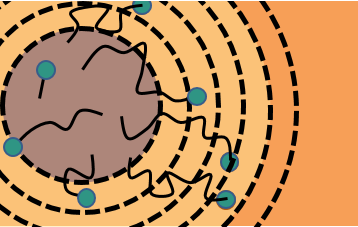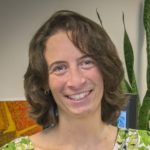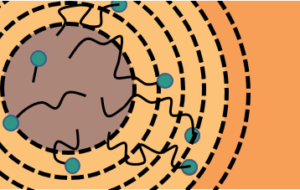In the first trillionths of a second after sunlight hits a photosynthetic organism, the energy that is absorbed flows through a dense network of protein-bound chlorophyll molecules to a dedicated location where it is converted to electric charges. This is the first step in a series of events that ultimately drives the formation of sugar and starch to store energy in chemical bonds.
“This migration is the triggering event that leads to all of the oxygen that we breathe, all of the food that we have, and we really don’t understand why this part of photosynthesis works as well as it does. For every photon of light that’s absorbed, you can expect some biochemical action to occur. That efficiency is really remarkable,” said Naomi Ginsberg, a faculty scientist in the Molecular Biophysics and Integrated Bioimaging (MBIB) Division who has a secondary affiliation in the Materials Sciences Division and is also a UC Berkeley associate professor of Chemistry and Physics.
When you look at the analogous process in synthetic organic semiconductors, there is ample room for improvement, she says. In these simplified model systems, harvesting energy from light likewise requires packets of energy similar to those in photosynthesis to travel to an interface where electronic charges are unleashed to generate electricity: a process referred to as exciton migration.
Exciton is the name scientists give to the format of the additional energy in a molecule, once that molecule has absorbed light. “You shine light and this electron becomes excited. It’s still bound to the molecule, and it’s attracted to the energetic void that it created by absorbing light, which we call a hole—something that has a positive charge instead of a negative charge like an electron,” Ginsberg explained.
When an exciton is migrating, it’s often called an electron-hole pair, she continued. “It’s moving over this array of many different molecules and then when it gets to a particular location there’s a driving force that will pull the electron and hole away from one another. So now you have these isolated charges and, because being far apart is a way of containing potential energy, you can use that to drive chemical reactions.”
Why exciton migration is so efficient in natural photosynthetic cells—and far less so in manmade materials—has been something of a mystery. The fleeting duration and the minuscule, yet critical, nanometer distances that the excitons travel, make it really difficult to observe what actually occurs during the migration process.
In previous experiments, researchers have shined light over the entire surface of a specially prepared material and measured light emitted to see how long it took to come out. However, that approach only gives an average perspective on how far and how fast excitons can migrate, and it neglects any sort of heterogeneity within the material.
So Ginsberg and her colleagues devised a measurement that transforms an optical “super-resolution” microscopy known as STED (stimulated emission depletion) into a tracker of excitons on these short scales in an organic semiconductor. The technique makes it possible, for the first time, to relate the characteristics of exciton migration efficiency to nanoscale structures within light harvesting materials. “We ended up using the spatial profile of light pulses and the way that they interact with the material in order to excite very small and localized regions that have very sharp boundaries,” she said.
Excitons that migrated beyond the boundary were quenched with another pulse, while those remaining fluoresced (owing to a property of the material itself), which showed how far the distribution expanded as a function of time. Along with former doctoral student Samuel Penwell (now a postdoc at the University of Chicago), former postdoc Rodrigo Noriega (now an assistant professor at the University of Utah), and graduate student Lucas Ginsberg (no relation), Ginsberg described the method in Nature Materials in November 2017.
The technique allowed her group to make several surprising discoveries, including what happens when energy gets trapped in a sort of “divot” in the material while en route to its destination. Imagine, Ginsberg explained, that the landscape that these excitons are traversing is not flat: there are hills and valleys. People had hypothesized that these valleys could make it much more difficult for the excitation to go very far, considering it only lives for a few nanoseconds.
“One thing that we found is that, at any given site where the energy happens to be, it’s almost as if the landscape is wiggling up and down, like in an earthquake, changing the energy of these excitons. That could potentially be really helpful in allowing them to get out of these valleys, and so we found that in this particular material that is in fact what happens. That’s an insight that we wouldn’t have without being able to make this specific measurement,” she said.
Ginsberg already has begun adapting the technique to be able to do these sorts of measurements in biomimetic light harvesting complexes developed by Matt Francis’s group in the Materials Sciences Division, and she hopes ultimately to be able to apply the method to natural photosynthetic systems. “For me, that’s been a dream for a long time so I’m super excited about it!”






